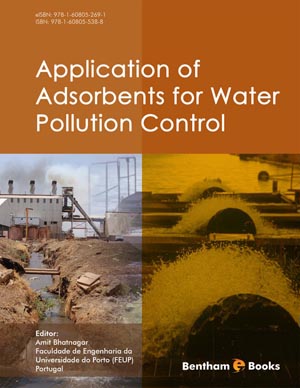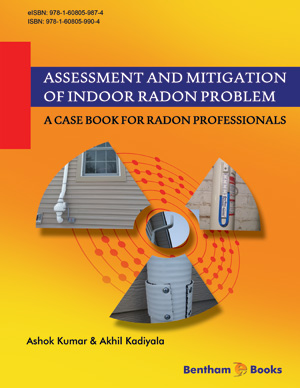Abstract
There are different types of floods and they are triggered by either natural or/and human factors. Floods become hazards when they cause damages to human society and ecosystems. Flood risk is a combination of flood probability and flood adverse consequences. Flood risk management involves flood risk analysis, evaluation and control. Some recent flooding examples in the UK are presented.
Relevant Probability Concepts
Page: 5-14 (10)
Author: Dawei Han
DOI: 10.2174/978160805047511101010005
PDF Price: $15
Abstract
Future floods cannot be predicted accurately. With our increased knowledge, epistemic uncertainty on floods can be reduced, but aleatory uncertainty is not reducible. Hence probability theory is the foundation for flood risk assessment and management. Floods can be treated as random variables with certain probability distributions.
Statistics in Hydrology
Page: 15-22 (8)
Author: Dawei Han
DOI: 10.2174/978160805047511101010015
PDF Price: $15
Abstract
The true probability distribution for floods at any catchment is unknown and has to be estimated. It is assumed that future floods will follow the same flood patterns as those in the past and we could derive the flood probability distribution based on the past flood records. Statistics is a branch of mathematics that helps us estimate flood frequency parameters.
Flood Frequency Analysis
Page: 23-33 (11)
Author: Dawei Han
DOI: 10.2174/978160805047511101010023
PDF Price: $15
Abstract
Floods can be characterised by peak flow, flood volume with a defined duration, or other attributes. They are considered as independent and identically distributed. Empirical flood frequency provides the basis for analytical flood frequency estimation. Computer software helps to speed up the frequency analysis process.
Frequency Curve Fitting
Page: 34-43 (10)
Author: Dawei Han
DOI: 10.2174/978160805047511101010034
PDF Price: $15
Abstract
Floods are complex and flood records tend to have errors. The two important points in flood frequency analysis are ‘1) All flood frequency curves are wrong, but some are useful; 2) ‘All data are wrong, but some are useful.’ The uncertainties with the frequency curve fitting can be reduced by various techniques to avoid overfitting and under-fitting.
Historical and Palaeo Floods
Page: 44-51 (8)
Author: Dawei Han
DOI: 10.2174/978160805047511101010044
PDF Price: $15
Abstract
In statistics, the longer the records are, the more accurate the statistical estimation would be. Historical and palaeo floods are important complementary data sources to instrumental floods. They should be integrated together to provide improved flood frequency estimations.
Regional Frequency Analysis
Page: 52-57 (6)
Author: Dawei Han
DOI: 10.2174/978160805047511101010052
PDF Price: $15
Abstract
Regionalisation is a useful approach in dealing with data poor catchments. A set of catchment attributes are used to select hydrologically similar catchments in order to overcome the data shortage problem.
Pooled Flood Frequency
Page: 58-64 (7)
Author: Dawei Han
DOI: 10.2174/978160805047511101010058
PDF Price: $15
Abstract
Hydrologically similar sites are pooled together to provide much longer records than those at the investigation site. Some key catchment attributes (descriptors) are used in establishing a pooling group through initial selection, discordancy check and heterogeneity test. The growth curve can be derived from the weighted contributions of individual group members.
Ungauged Catchments
Page: 65-70 (6)
Author: Dawei Han
DOI: 10.2174/978160805047511101010065
PDF Price: $15
Abstract
To estimate flood frequency at catchments without river flow records, there are several approaches available (catchment descriptors, data transfer, rainfall runoff modelling and channel dimensions). They have varied accuracies and multiple approaches may be explored to derive reasonable flood estimates.
Areal Rainfall
Page: 71-79 (9)
Author: Dawei Han
DOI: 10.2174/978160805047511101010071
PDF Price: $15
Abstract
Rain gauge networks have limited spatial resolutions. Conventional methods such as Thiessen Polygon method, Isohyetal method and Reciprocal-distance-squared method are easy to use but unable to provide information on uncertainties. Geostatistical methods such as Kriging are able to provide point rainfall estimation and catchment average rainfall, as well as uncertainty information on the estimated values.
Rainfall Runoff Modelling
Page: 80-86 (7)
Author: Dawei Han
DOI: 10.2174/978160805047511101010080
PDF Price: $15
Abstract
Due to their relatively low costs, there are more rain gauges than river flow stations. In addition, rainfall records are usually much longer than river flow records. As a result, rainfall runoff modelling helps flood engineers to convert rainfall records into river flows.
Rainfall Frequency Analysis
Page: 87-96 (10)
Author: Dawei Han
DOI: 10.2174/978160805047511101010087
PDF Price: $15
Abstract
Like flood frequency analysis, individual rainfall event has a return period attached to it. Rainfall has two important attributes: depth and duration, hence rainfall frequency analysis involves the depthduration- frequency model (DDF). A DDF can be used to estimate design rainfall or to assess rarities of observed rainfall events.
Probable Maximum Precipitation and Probable Maximum Flood - PMP and PMF
Page: 97-102 (6)
Author: Dawei Han
DOI: 10.2174/978160805047511101010097
PDF Price: $15
Abstract
In flood risk management, it would be useful to know the upper limit for the maximum precipitation at a specific site. It may be estimated by storm models, maximisation of actual storms or generalised charts. The maximum flood and maximum storm can be derived from the maximum precipitation. Since we are not very sure about these estimates, it is important to prefix ‘probable’ to the terms to emphasise the significant uncertainties with these values.
Flood Hazard Mapping
Page: 103-106 (4)
Author: Dawei Han
DOI: 10.2174/978160805047511101010103
PDF Price: $15
Abstract
Flood hazard maps provide very useful information for the general public and flood risk management professionals. They are constructed from inundation maps of a defined return period. If flood vulnerability information is available, a flood hazard map may be converted into a flood risk map.
Nonstationary Time Series
Page: 107-114 (8)
Author: Dawei Han
DOI: 10.2174/978160805047511101010107
PDF Price: $15
Abstract
Frequency analysis assumes that extreme rainfall and flood values are generated from independent and identically distributed random variables. If a data series is nonstationary with trend or step change, the fundamental assumption for frequency analysis will be seriously challenged, and this will have tremendous implications for probability assessments of the magnitude and frequency of future floods. There are several statistical tests available for identifying the nonstationarities in the rainfall or flow records.
Coastal Flooding
Page: 115-121 (7)
Author: Dawei Han
DOI: 10.2174/978160805047511101010115
PDF Price: $15
Abstract
More than half of the world population lives in the coastal zone. As a result, coastal flooding is a major threat to human society. A flood from sea may be caused by a heavy storm (storm surge), a high tide, a tsunami, or a combination of them. Knowledge in costal processes and sea wave models enables engineers to design and manage effective costal defence systems based on soft and hard engineering measures.
Real-Time Flood Forecasting
Page: 122-127 (6)
Author: Dawei Han
DOI: 10.2174/978160805047511101010122
PDF Price: $15
Abstract
Flood forecasting is a non-structural measure in flood risk management. Real-time flood forecasting provides valuable information for flood warning services so that the general public and emergency agencies would have sufficient time to prepare counter-measures against the impending floods.
Flood Risk Mitigation
Page: 128-134 (7)
Author: Dawei Han
DOI: 10.2174/978160805047511101010128
PDF Price: $15
Abstract
There are structural and non-structural flood mitigation measures. Risk and uncertainty analysis is the foundation for designing and choosing appropriate flood mitigation options. The socioeconomic analysis is becoming increasingly important in the future.
Weather and Climate Change
Page: 135-141 (7)
Author: Dawei Han
DOI: 10.2174/978160805047511101010135
PDF Price: $15
Abstract
Human activities could have important impacts on weather and climate at local, regional and global scales. However, it is also important to realise that climate has always been naturally changing with time. Modelling global climate change is very difficult and subjective. The techniques used and results obtained in climate modelling provoke controversy, therefore there are huge uncertainties with the ’predictions‘ provided from all the existing climate modelling systems.
Self Test Questions
Page: 142-147 (6)
Author: Dawei Han
DOI: 10.2174/978160805047511101010142
PDF Price: $15
Abstract
The questions described in this chapter may be used by readers to check your levels of understanding of this book and the related reading materials. You should be able to attempt all the questions (each with 20 marks) within 3 hours and the full mark for this exercise is 100. A formula sheet is appended on the last page for a quick reference.
Introduction
Floods are devastating natural disasters with a significant impact on human life and the surrounding environent. Flood Risk Assessment and Management should serve as an Ideal textbook on analytical flood risk assessment and management, and is intended for lecturers, undergraduates and postgraduates in civil engineering, geography, environmental science, earth sciences, and related disciplines. This book is based on the lecture notes taught at the University of Bristol to students undertaking a Masters course in civil engineering. All chapters are supplemented with challenging questions, answers and solutions.












